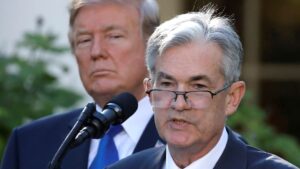Understanding the Federal Reserve’s Impact on Your Personal Finances
At Extreme Investor Network, we believe knowledge is power—especially when it comes to your finances! Today, we’re diving into how the decisions made by the Federal Reserve (Fed) can directly impact your wallet. As markets fluctuate and interest rates remain a hot topic, let’s break down what it all means for you.
The Current Landscape: A Steady Fed
As political pressure builds against Fed Chair Jerome Powell, many are watching closely as the Fed is expected to hold interest rates steady. Despite ongoing criticisms from high-profile figures like former President Donald Trump, financial markets signal little likelihood of an immediate rate cut. According to the CME Group’s FedWatch gauge, the chances of a reduction in the federal funds rate are virtually zero. So, what does this mean for everyday consumers?
The Ripple Effect on Your Finances
The federal funds rate is not just a number—it affects the borrowing and savings rates that average Americans encounter daily. A steady rate can lead to challenges for consumers, particularly those grappling with high prices and elevated borrowing costs.
Credit Cards
High credit card debt continues to be a significant issue for many consumers. Since most credit cards have variable rates, they’re directly influenced by the Fed’s actions. Currently, the average APR for credit cards sits above 20%, almost at last year’s all-time high.
What You Can Do: If you’re feeling the pinch, consider transferring your balance to a zero-interest credit card or consolidating with a lower-rate personal loan. "The truth is that people have more power over the rates they pay than they think," says Matt Schulz, chief credit analyst at LendingTree.
Mortgages
When it comes to home buying, mortgage rates are staying locked in a narrow range. As of now, a 30-year fixed-rate mortgage hovers near 6.9%. This stagnation, compounded by limited housing inventory, makes home buying increasingly challenging for many.
Pro Tip: If you’re in the market, be prepared for consistently high rates, and shop around diligently. Your mortgage can be one of the most significant financial commitments you’ll make, so every percentage point counts!
Auto Loans
Though auto loan rates are largely fixed and not directly tied to the Fed, rising vehicle prices mean higher payments. Currently, the average five-year new car loan sits at 7.24%. With many households paying more than $1,000 monthly for their car payment, buyers need to be strategic.
Smart Strategy: Consider shopping for financing before heading to the dealership. A little research can lead to significant savings on your financing terms.
Student Loans
For student loan borrowers, the recent volatility may seem less impactful. Federal student loan rates are fixed, based on the last 10-year Treasury note auction. The current rates for undergraduate loans sit at 6.53%. However, fewer loan forgiveness options now exist, adding to the stress students may feel.
Financial Advice: Review your loan options periodically, including income-driven repayment plans that might ease your burden.
Savings Accounts
On a more positive note, savings accounts are experiencing a return to favor, with top yields above 4%. While the Fed doesn’t directly dictate these rates, a steady federal funds rate helps maintain elevated savings yields.
Savers Take Note: Make sure your money is parked in a high-yield account to maximize your earning potential.
The Bottom Line
In this complex financial landscape, having access to reliable information is essential. The Fed’s decisions can ripple through your everyday financial life, impacting everything from credit cards to savings accounts. As the situation evolves, staying educated and proactive is your best strategy for financial wellness.
At Extreme Investor Network, we strive to empower you to take control of your financial future. For personalized insights and further resources, stay tuned to our blog and explore the tools we offer to help you achieve your financial goals!

